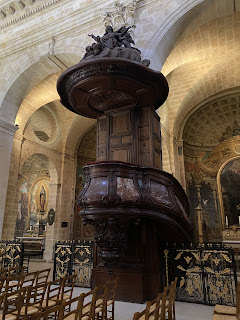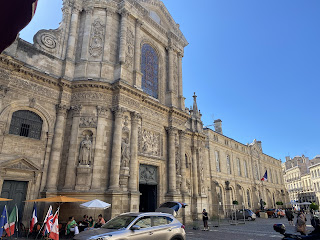Although it is now actually July 6th here (I fell asleep before I was able to finish this blog), I thought I should write up a post since it has been a couple of days since my last one. There wasn’t much to report on Monday, as I spent the day in train stations or on the train going from Chartres to Paris and Paris to Bordeaux. One observation that I’ve made about France is that all the buildings - and I mean ALL of the buildings are beige. Most are made of stone, but if it’s plaster, it’s painted beige like the stone. What make most of the towns colorful are the many vibrant colors they use to paint trim or shutters and all the flowers in gardens or in pots along the sidewalk or in window boxes.
I’m in a lovely apartment in the old town of Bordeaux. I have been immensely blessed with my accommodations - great AirBnB locations and hosts. I planned a week in Bordeaux as I’m interested in slowing the pace a bit, relaxing more and enjoying my surroundings. There is definitely a thing called “travel weariness” when you move from town to town and try to see and do everything. Even though I had scheduled to be here in Bordeaux for a week, aside from being well known worldwide for its wine and gastronomy, I really wasn’t sure what Bordeaux, as a city, had to offer. I am being pleasantly surprised.
There have been settlements in Bordeaux, originally called Burdigala by the Celts, since 300 BC. Romans ruled the city and surrounding area from around 60 BC and it became an important commercial center for tin and lead. But Bordeaux remained relatively obscure until the 12th Century when William the Conqueror became King of England and Duke of Normandy. His conquests through war, marriage, and heirs became known as the Angevin Empire which encompassed most of the British Isles and half of France down through Bordeaux to the Pyrenees. It was during this time, beginning in 1157 for about 100 years, when Bordeaux flourished.
I am living/staying in the midst of all that flourished 900 years ago. Similar to my stays in southern Spain, there are narrow streets and tiny shops everywhere. The most common shops are food related - cafes, pastry, gelato, spice, tea, cheese, wine, bars, and restaurants, as well as very small grocery stores - kind of like the roadside stand at a farm at the end of the driveway when you drive through the country. But, here, the cart has been pulled into a tiny shop in town. Although Bordeaux is the 6th largest city in France, it holds the 2nd most UNESCO identified historical buildings; 2nd only to Paris. I found a map generated by UNESCO and the tourist trade that suggests a walking tour of many of those sites. The self-guided walking tour is about 4 hours long. I thought I’d do part of it on Tuesday and the rest Wednesday, but once I began I ended up doing the whole route. There are a few outliers, not part of the walking tour, that I might try to see on Wednesday.
Below are some of the pictures I took. Yes, there are more cathedrals/churches.
This is the Grosse Cloche - the historic town belfry and the only remains of the wall that was built in the 13th Century. On top is a golden weather vane of a lion, representing the Kings of England. The current bell was cast in 1775 and weighs over 17,000 pounds! I’m staying on a side street just off this one.
Place de la Bourse and the Three Graces Fountain. Originally this large area was called the Royal Square, flanked by the Stock Market Building and the Bordeaux Patrimoine Mondial, a discovery center on Bordeaux’s history.













































No comments:
Post a Comment